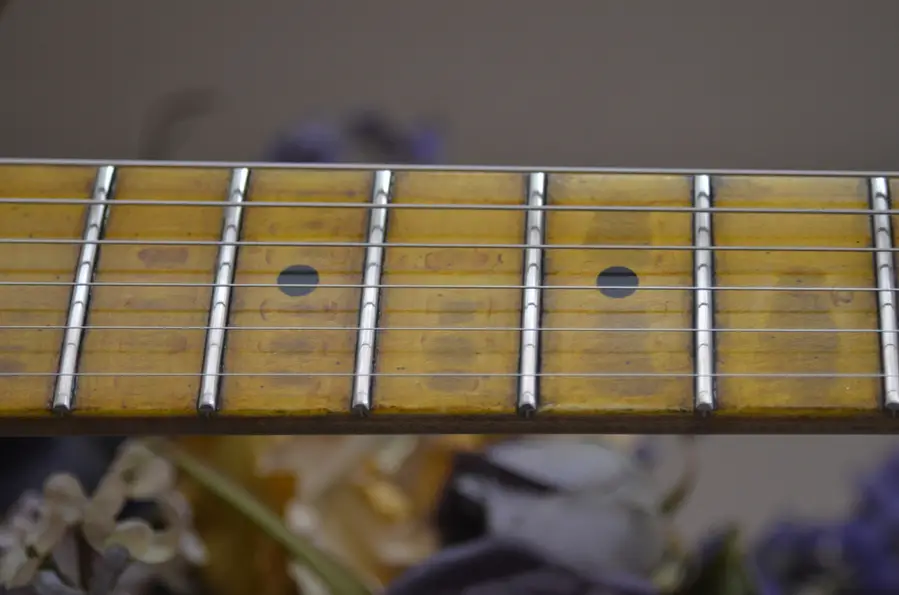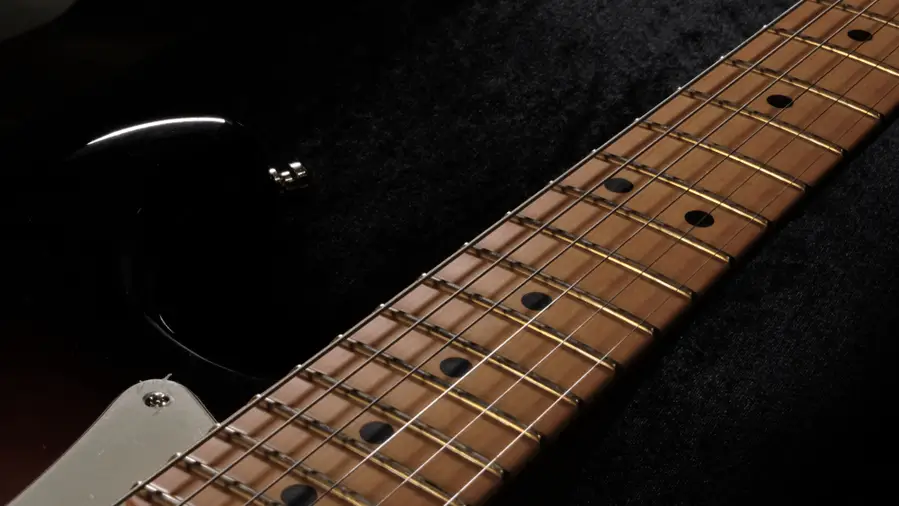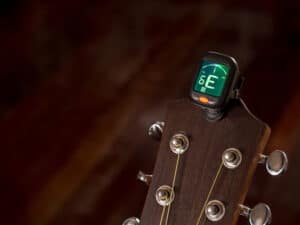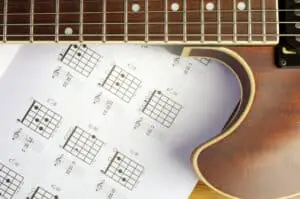
Whether you’re strumming lightly or picking heavily, your guitar frets still wear out over time. This is because every time you press your strings against the frets, the friction between the metals in contact subtly changes the shape of the frets.
The condition of your frets greatly affects how your guitar sounds, so it’s not an issue you can ignore. Your guitar frets may already be showing signs of wear, but how much fret wear is too much?
Fret wear is too much when your guitar starts sounding wonky due to fret buzz, string damage, or intonation issues. Basically, if your guitar starts sounding weird and you notice some damage on the frets, then it’s time to fix or replace them.
Here’s everything you need to know on guitar frets and fret damage.
What Are Frets Made Of?

Ever wondered what materials your guitar frets are made of? Below are some common materials.
Nickel Silver
Most frets are made of nickel silver. From the name, you may think there’s silver in this alloy, but there isn’t. Nickel silver comprises 80 percent copper, 18 percent nickel, and other materials like zinc. The best nickel-silver fret wires usually have less copper and more zinc.
The reason why nickel silver is used by guitar manufacturers to make fret wires is that it’s easy to bend and it’s resistant to skin oils. However, the flexibility of nickel silver also makes it susceptible to wear and tear.
Stainless Steel
If you check the spoon you eat breakfast with, it’s probably made of stainless steel. Stainless steel is sturdy and can withstand pressure, so they’re used to make guitar frets.
Can frets made of stainless steel wear out? Of course, but not as fast as nickel-silver frets. If you press your strings harder than usual, you should consider buying stainless steel frets.
With stainless steel frets, you may never need to change or replace your guitar frets. However, they are more slippery and expensive than nickel-silver frets. Because they’re also harder to cut, you’ll spend a lot replacing them if they wear.
Another disadvantage of stainless steel frets is that they may damage your guitar strings; stainless steel frets are harder on the strings. If you use steel strings and steel frets, the friction will be even more, and your frets and strings will wear out faster.
Why Do Frets Wear Out?

Fret wear is mainly caused by your guitar strings constantly rubbing your guitar fret wire. The pressure and friction cause your frets to deteriorate.
You don’t need to worry because it’s a slow process that often takes years before you notice any major damage. However, it’s inevitable. Here are some factors that can affect the speed of fret wear.
Fret Material
As mentioned earlier, nickel-silver frets wear out faster than their stainless steel counterparts. However, stainless steel frets are more expensive and harder to work with. If you are an average guitar player, you don’t need stainless steel strings because your frets won’t wear out fast when you play normally. But if you often press too hard on your frets, you should get steel frets.
The Kind of Strings You Play With
Since both your strings and frets are made of metal, the friction they produce when they come in contact causes the weaker one to wear. The thicker strings on your guitar i.e., the E, A, and D, are often nickel-plated, while the thinner strings—G, B, E—are plain steel.
Hence, the thinner strings are going to do more damage to your frets. If you’ve been playing for quite some time and you check your frets, you’ll see that there’s more wear under the thinner strings.
How You Play
Your playing style also greatly affects how fast your strings wear out. If you’re a budding Jimi Hendrix who loves to do string bends, vibrato, heavy strumming, and fast picking, your frets will wear out much faster than playing normally.
Also, If you regularly use capos, you’ll also notice your frets wearing out faster than normal because capos flatten the frets. The pressure they exert on your frets causes them to degrade quickly.
Signs Your Frets Are Worn Out

Now that you know what damages your frets, how do you know when exactly your frets are worn out? Here are some signs.
Fret Buzz
Fret buzz is the annoying sound you hear when your guitar strings rattle or buzz against a fret wire.
It’s often caused when your frets are not level with each other (if you’ve used a capo too much on a fret, the height decreases and it causes fret buzz), or your string action is too low (your strings are too close to the fretboard).
Dents
Playing your instrument frequently will surely cause divots, dents, and flat spots. These indicators don’t usually mean your frets are worn out, but too much of them to the point your guitar starts to sound abnormal is a sign that your frets are worn out.
Intonation Problems
If you tune your strings, and they still sound out of tune, then this has to do with the intonation of your instrument. Worn-out frets negatively impact how your guitar sounds, and more often than not, you’ll have to replace your frets if you have intonation issues.
Flattened Frets
Look closely at your guitar frets. Do some seem flatter or lower than others? If so, this is one of the earliest signs of fret wear called flattening. Flattening is often caused by the pressure of your guitar strings or using a capo too often.
Pits
Pits are cavities in guitar frets formed by guitar strings. They’re the later stages of fret wear and can occur anywhere on the fretboard. If your guitar has too many pits, it becomes harder to play, and the little holes can obstruct your string when bending.
Takeaway
Try not to care too much about fret wear because it seldom happens, and it’s even a sign you’re using your instrument well. If you notice any wear, you can take your guitar to your nearest guitar store and have a technician fix it for you.








